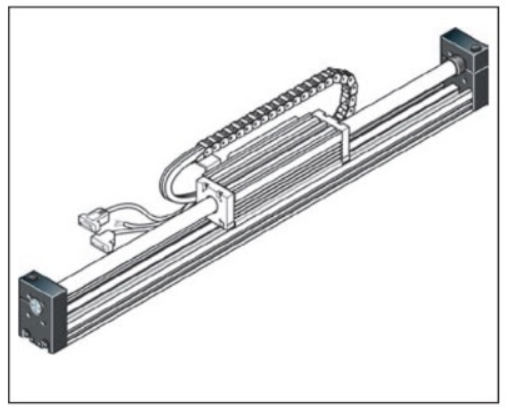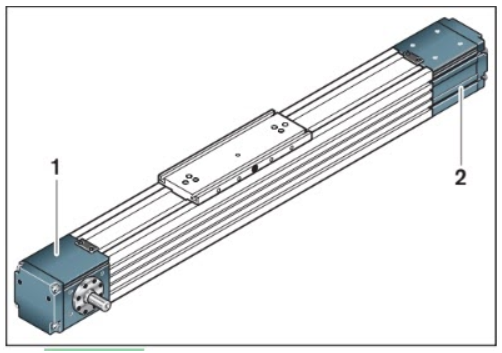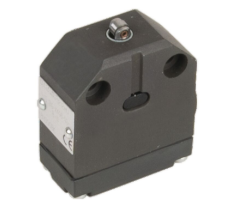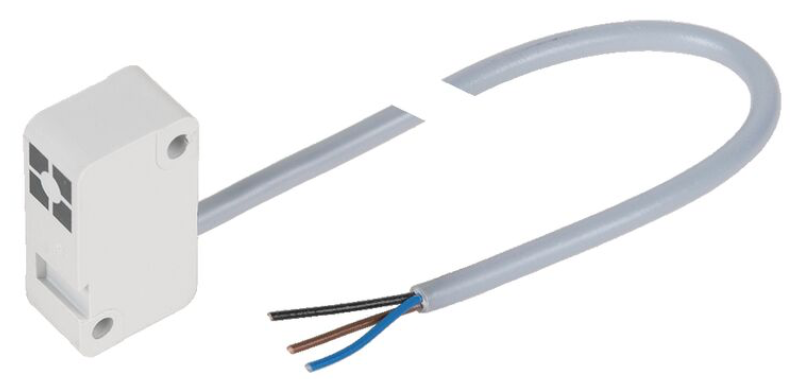End Enclosures
- Ball Screw Drive End Enclosures

Ball Screw Assembly End Blocks. Picture #1: End Blocks (1) Drive End Block, (2) Idler End Block. Picture #2: Expanded Picture of Drive End Block. Picture #3: Expanded Picture of Idler End Block. (BOSCH, 2007)
The linear motion systems with ball screw drive have end blocks which houses the ball screw’s end bearings. One end block has the screw shaft journal protruding out from it, which allows a motor to drive the ball screw. This type of end block is called a drive end block. The other end block just has the bearings and is called a idler end block
- Linear Motor

Linear Motor End Enclosures. (BOSCH, 2007).
The end blocks that come with linear motors serve as both end covers for the frame and as stops to prevent the carriage from overshooting. Unlike end blocks for toothed belt drives or ball screw drives, these end blocks do not have a shaft, as the thrust for the carriage is directly generated at the carriage.
- Toothed Belt Drive End Enclosures

Toothed Belt End Enclosures. Picture #1: Toothed Belt End Enclosures: (1) Drive End Enclosures, (2) Tension End Enclosure. Picture #2: Expanded Picture of Drive End Enclosure. Picture #3: Expanded Picture of Tension End Enclosure.
Linear Motion Systems with toothed belt drive have two different types of enclosures, a drive end enclosure and a tension end enclosure. The drive end enclosure is where the motor and the toothed wheel transforms the rotational motion of the motor to linear motion of the belt. The tension end enclosure houses a bearing mounted pulley which can be tensioned by adjusting the position of the pulley.
Gear Units
Gear Units are special types of gearing, and thus are able to adjust the torque and speed of the linear motion system. Bosch Rexroth has two types of gear units: timing belt side drives and planetary gears. The planetary gear units attach to the side of the system, while the timing side belt drive attaches underneath. For either type, a locating feature and a fastening thread are provided in order to attach the motor or gear unit.
If a timing side belt drive is used, then the overall length of a system may be reduced compared to one with a direct motor attachment.
Electrical Components
Bosch’s linear motion systems come with a variety of electrical components in order to drive and control the carriage. The main electrical components that Bosch has for their linear motion system includes motors and switches.
Motors
Certain types of drive systems, such as ball screw assemblies or toothed belt drives, require a secondary drive unit. For linear motion systems, this secondary drive unit is usually in the form of a motor.
Bosch provides the user with their own motors, which come pre-assembled with a motor housing.
If the user wants a different motor than what Bosch provides, then they would need to fill out a separate form in order to have a housing made special for the motor. Bosch sells these three types of motors: servo motors, stepper motors, and three phase motors. The following details the pros and cons with each of the three types of motors that Bosch Rexroth provides:
1.Servo Motors
-
- Pros:
- Servo motors often have high amounts of torque and angular speeds.
- Servo motors provide the best accuracy and dynamical characteristics for linear motion systems.
- Servo motors have better noise characteristics than the stepper motor or the three-phase motor.
- Pros:
-
- Cons:
- These motors have worse handling than the other two motors.
- The servo motors that Bosch provides are more expensive than the other types of motors Bosch provides.
- Cons:
2.Stepper Motors
-
- Pros:
- Stepper Motors have decent torque, accuracy, and handling.
- They are relatively cheaper than the other motors that Bosch sells
- Pros:
-
- Cons
- Have a lower range of speeds compared to the other motors.
- Have the worst noise characteristics out of the other motors that Bosch sells.
- Cons
3.Three-Phase Motors
-
- Pros:
- The three-phase motors that Bosch sells are relatively cheap.
- Three-Phase Motors have good speed and handling characteristics.
- Three-Phase Motors have good noise characteristics.
- Pros:
-
- Cons:
- Low torque and accuracy ratings.
- Worse dynamical characteristics than the other two types of motors
- Cons:
Switches and Sensors
Another type of electrical accessory that comes with most linear motion systems is switches. As explained in the Structure of Linear Motion Systems, switches come in two forms: Limit Switches and Reference Switches. Bosch Rexroth sells two types of limit switches: Mechanical Switches and Reed Switches; and two types of reference switches: proximity switches and hall sensors. The below details the working process between each of the different types of switches.
- Mechanical Switches

Mechanical Switch. Resource: https://store.boschrexroth.com/?cclcl=en_US.
The mechanical switches that Bosch provides are roller limit switches. Linear Motion Systems with these types of switches installed include a side cam. As the cam rolls over the switch, the switch opens the current which stops the carriage.
The benefits of using this switch instead of others is that it is less likely to cause interference with other types of sensors. However, the accuracy of the switch is lowered as the speed of the carriage is increased. For the mechanical switch, it is recommended not to approach the switch at a speed greater than 1 m/s.
- Proximity Switch

Proximity switches detect when an object passes in front of the sensors. Unlike mechanical switches, proximity switches are able to send analog signals, making them able to act as a limit switch and a reference switch. Proximity switches can be either inductive or capacitive, however the ones that Bosch sells are inductive. Inductive Proximity switches work on metallic object moving across an electromagnetic field produces eddy currents. The inductive sensor produces a weak electromagnetic field. When the carriage moves across, the field is dampen through the eddy currents, which is measured at the sensor.
- Hall Sensor/Reed Switch

Both Hall Sensors and Reed Switches are sensors that detect the presence of a magnetic field. Linear Motion Systems with either type of sensor comes equipped with a magnet attached to the carriage.
The main difference between the hall sensors and reed switches is that hall sensors can produce an analog signal while reed switches produces a digital signal. Because of this, hall sensors are considered to be reference switches while reed switches are considered to be limit switches.
The main principle behind a hall sensor is the Hall Effect; when a magnet passes over a semiconductor that has current flowing through it, the Lorentz force pushes negative charge to one end on the material. The excess of negative charge on one end pushes positive charges to the other end. This creates a voltage across the semiconductor that is proportional to the strength of the magnetic field passing through the material. Since the strength of a magnetic field is dependent upon the material’s distance from the magnet, the hall sensor can detect the distance of the carriage from the sensor.
Reed switches work because they have two ferromagnetic strips that are placed so that there is a small gap. There are two types of reed switches, normally open and normally closed. In normally open reed switches, a magnetic field causes the strips to attract each other so much that they contact each other, which completes the circuit. When the magnetic field is removed, the spring force from the metal returns the strips back to their original positions and thus stopping the flow of current. In normally closed reed switches, a normally open reed switch is attached with a permanent magnet. When a magnet with the same polarity gets closed to the magnet, the magnetic field cancel each other, thus opening the circuit.





